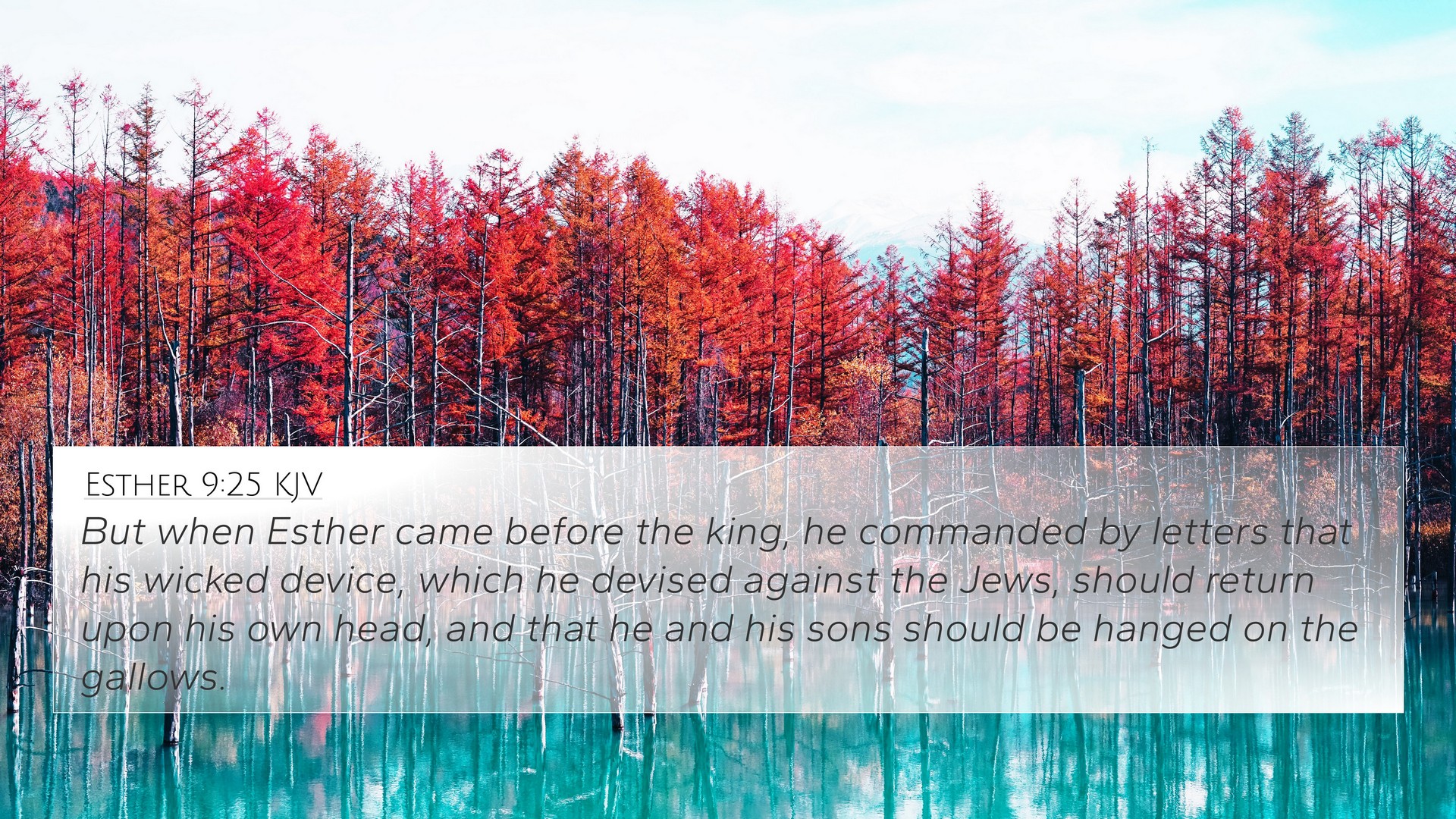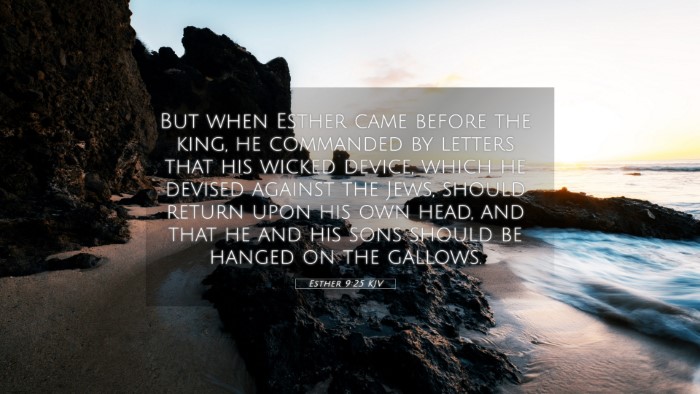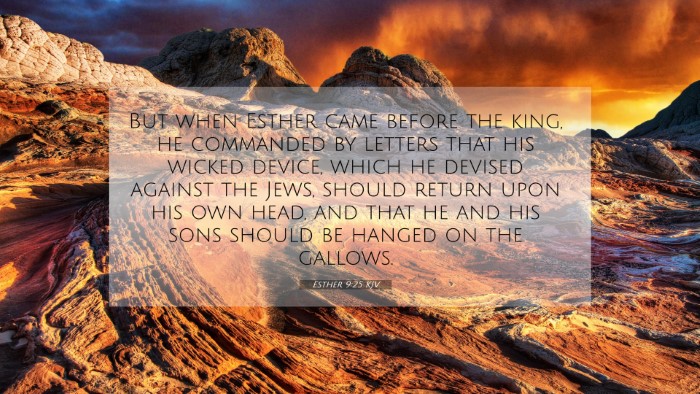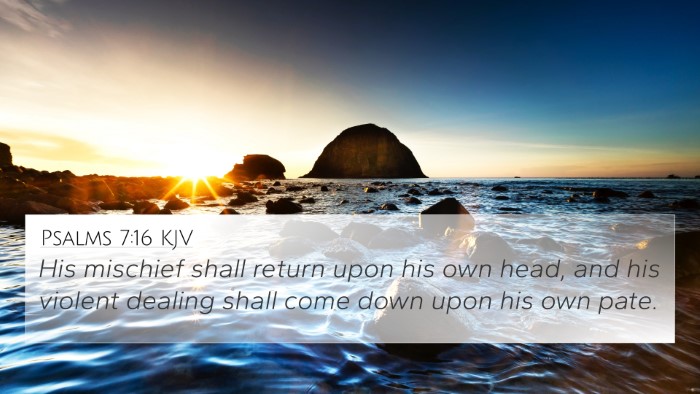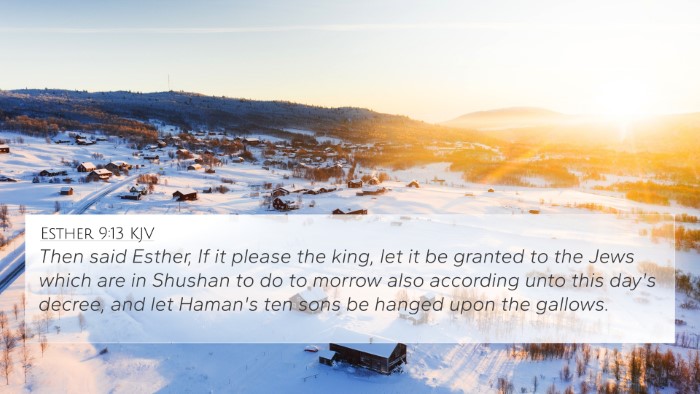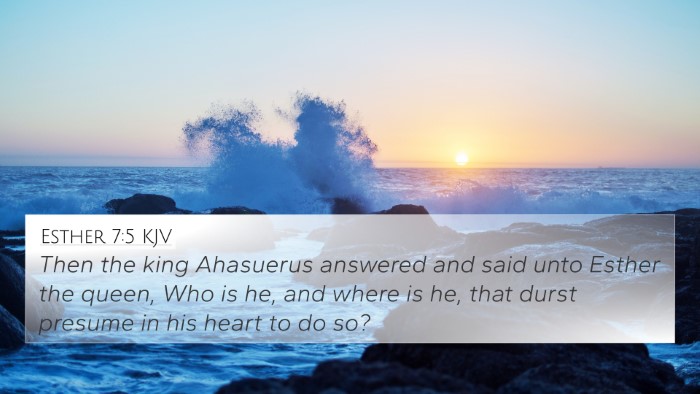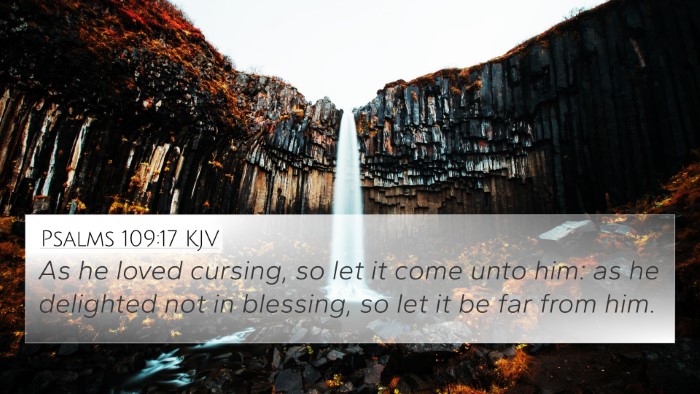Understanding Esther 9:25
Esther 9:25 is a poignant verse that encapsulates the essence of divine providence and justice within the narrative of Esther. The verse reads: "But when Esther came before the king, he commanded by letters that his wicked device, which he devised against the Jews, should return upon his own head, and that he and his sons should be hanged on the gallows."
Contextual Overview
This verse is situated within the conclusion of the Book of Esther, where the Jewish people face annihilation at the hands of Haman, an Agagite. Following Haman's plot against the Jews, Esther's intervention leads to a dramatic reversal of fate, demonstrating how God can turn the plans of the wicked against them.
Commentary Insights
-
Matthew Henry:
Henry emphasizes the triumph of justice in Esther 9:25, noting that divine justice prevails as Haman's malicious intentions are turned against him. This reflects the biblical truth that God does not allow evil to go unpunished.
-
Albert Barnes:
Barnes highlights Esther's courage and the significance of her entering the king’s presence. The king’s decree to punish Haman serves as a reminder of how the tables can turn when one stands up against wickedness, further illustrating the theme of retribution found throughout scripture.
-
Adam Clarke:
Clarke elaborates on Haman's downfall as a demonstration of God's providence. He points out the irony that Haman, who intended to execute the Jews, ultimately suffers the fate he designed for them. This serves as an important lesson in humility and the dangers of hubris.
Thematic Connections
Esther 9:25 illustrates several major themes: divine justice, the power of prayer and advocacy, and the vindication of the oppressed. These themes resonate with various Biblical narratives where God intervenes for His people.
Cross-References
- Proverbs 26:27: “Whoso diggeth a pit shall fall therein: and he that rolleth a stone, it will return upon him.” - This verse highlights the principle of self-inflicted consequences for those who scheme against others.
- Galatians 6:7: “Be not deceived; God is not mocked: for whatsoever a man soweth, that shall he also reap.” - Echoing the theme of divine justice, this New Testament verse reinforces the idea that evil deeds will have repercussions.
- Psalm 7:15-16: "He made a pit, and digged it, and is fallen into the ditch which he made." - Reflects the thematic connection that aligns with Haman's destructive plans turning upon himself.
- Job 4:8: “Even as I have seen, they that plow iniquity, and sow wickedness, reap the same.” - Job's observation supports the moral law of reaping and sowing, applicable in Haman’s case.
- Isaiah 54:17: “No weapon that is formed against thee shall prosper.” - This verse reassures God’s protection over His people, aligning with Esther's narrative of deliverance.
- Matthew 7:2: “For with what judgment ye judge, ye shall be judged.” - Illustrates the principle of reciprocal justice, much like Haman's eventual fate.
- Psalm 9:15: “The heathen are sunk down in the pit that they made: in the net which they hid is their own foot taken.” - This ties directly into the narrative of Esther, where the enemies of the Jews fall into the traps they set.
- 2 Thessalonians 1:6: “Seeing it is a righteous thing with God to recompense tribulation to them that trouble you.” - This apostolic insight echoes God’s divine justice that culminates in the fate of Haman.
- Exodus 17:14: “And the LORD said unto Moses, Write this for a memorial in a book, and rehearse it in the ears of Joshua: for I will utterly put out the remembrance of Amalek from under heaven.” - Reflects God's intent to deal decisively with His enemies.
- Revelation 20:10: “And the devil that deceived them was cast into the lake of fire and brimstone.” - Encompasses the ultimate justice against those who oppose God’s people.
Conclusion
Esther 9:25 serves not just as a narrative climax, but as a significant lesson in justice, courage, and God’s unwavering protection over His people. The connections between this passage and other scriptures enhance its impact and provide a deeper understanding of its broader significance within biblical theology.
Using Cross-References for Bible Study
For those interested in pursuing a more thorough study, utilizing tools for Bible cross-referencing can illuminate thematic links throughout the scriptures. A Bible concordance or a cross-reference Bible study guide can further assist in discovering interconnections and enhancing your interpretation and understanding of passages like Esther 9:25.
Tools for Further Study
Engaging with comprehensive Bible cross-reference materials will aid in exploring how Biblical texts speak to each other. Techniques such as cross-referencing Bible study methods, or using a Bible cross-reference system can enrich one's study and interpretation of scripture.
